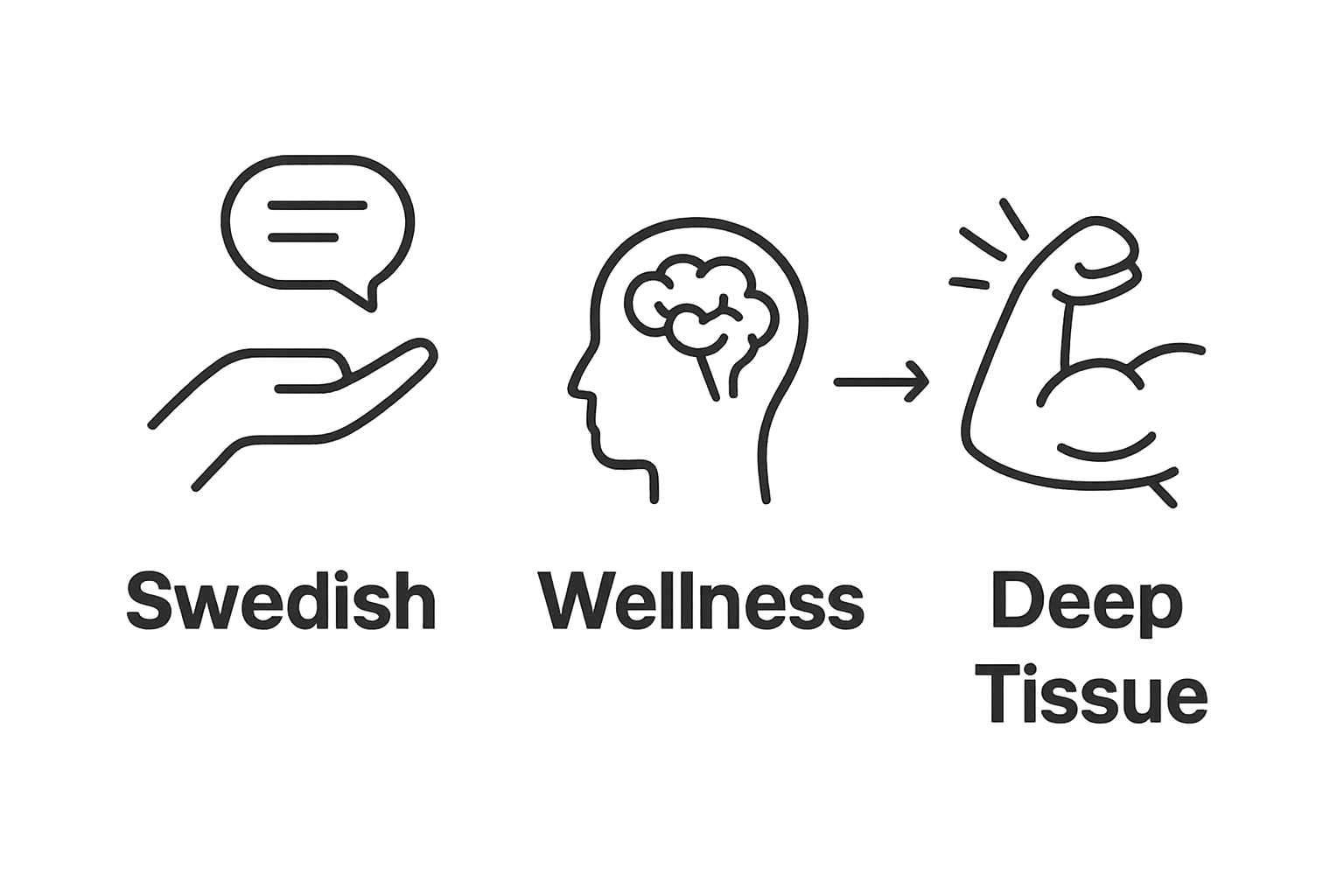Massage therapy is everywhere and people swear by its relaxing touch. But the science behind it points to something even more impressive. Studies show that massage can reduce anxiety and depression symptoms by up to 50 percent for many clients. This means its real power might be in healing both body and mind in ways most folks never realize.
Table of Contents
- What Is Massage Therapy And Its Benefits?
- Why Massage Matters For Physical And Mental Health
- How Massage Works: Mechanisms And Effects On The Body
- Key Concepts In Massage Therapy: Techniques And Outcomes
- The Role Of Massage In Holistic Wellness Approaches
Quick Summary
| Takeaway | Explanation |
|---|---|
| Massage therapy reduces muscle tension and pain. | Regular massage can alleviate chronic pain and muscle stiffness, promoting physical comfort. |
| Enhances mental health by reducing stress. | Therapeutic touch helps lower anxiety levels and supports emotional well-being through relaxation. |
| Improves circulation and lymphatic drainage. | Massage techniques boost blood flow, promoting nutrient delivery and waste removal in the body. |
| Supports immune system function and recovery. | By reducing stress and inflammation, massage therapy aids in faster physical recovery and strengthens immune health. |
| Addresses both physical and emotional health. | Massage offers a holistic approach, recognizing the interplay between bodily and mental wellness for comprehensive health management. |
What is Massage Therapy and Its Benefits?
Massage therapy is a holistic healing practice involving systematic manipulation of soft body tissues to promote physical and mental wellness. By strategically applying pressure, kneading, and movement techniques, registered massage therapists help clients restore balance and support overall health.
Understanding the Foundations of Massage Therapy
At its core, massage therapy is a targeted approach to healing that goes beyond simple relaxation. Registered Massage Therapists use specialized techniques to address specific physiological and psychological needs. The practice encompasses various methods designed to stimulate circulation, release muscle tension, reduce stress, and support the body’s natural healing processes.
The fundamental principles of massage therapy are rooted in understanding human anatomy and the interconnected nature of physical and mental wellness. Therapists recognize that tension, pain, and stress can manifest in multiple body systems, requiring a comprehensive approach to treatment.
Key Benefits of Professional Massage
According to research from the National Center for Complementary and Integrative Health, massage therapy offers significant wellness advantages:
- Reduces muscle tension and chronic pain
- Decreases stress and anxiety levels
- Improves blood circulation and lymphatic drainage
- Supports immune system function
- Enhances overall mental and physical relaxation
Professional massage therapy provides a natural, non-invasive approach to addressing various health challenges.
This table summarizes the various physiological and psychological benefits of massage therapy as outlined in the article.
| Benefit | Physical Impact | Mental/Emotional Impact |
|---|---|---|
| Reduces muscle tension and pain | Relieves chronic pain, eases muscle stiffness | Increases relaxation |
| Improves circulation and lymph drainage | Enhances nutrient delivery, removes metabolic waste | Supports healing and recovery |
| Decreases stress and anxiety | Lowers cortisol, calms nervous system | Reduces anxiety and emotional distress |
| Boosts immune system function | Reduces inflammation, supports cellular repair | Enhances resilience |
| Supports overall relaxation | Releases physical tension | Promotes emotional regulation |
| By targeting specific muscle groups and employing specialized techniques, therapists can help clients achieve deeper physical comfort and improved emotional well-being. |
Why Massage Matters for Physical and Mental Health
Massage therapy represents a powerful holistic approach to wellness that addresses both physical symptoms and psychological challenges. By understanding how therapeutic touch impacts our body and mind, individuals can leverage massage as a critical component of comprehensive health management.
The Physiological Impact of Massage
Massage therapy triggers profound physiological responses that extend far beyond temporary relaxation. When skilled therapists apply targeted techniques, they stimulate the body’s natural healing mechanisms. Pain Relief Stress Therapy techniques help interrupt chronic pain cycles, reduce muscle tension, and promote improved circulation.
Scientific research demonstrates that massage directly influences our nervous system. Through strategic manipulation of soft tissues, massage can lower cortisol levels, decrease inflammation, and enhance immune system functioning. These biological changes contribute to faster recovery, reduced physical stress, and improved overall bodily resilience.
Mental Health and Emotional Wellness
According to research from the International Journal of Neuroscience, massage therapy produces significant psychological benefits:
- Reduces symptoms of anxiety and depression
- Increases production of mood-enhancing neurotransmitters like serotonin and dopamine
- Promotes deeper relaxation and emotional processing
- Helps manage stress-related psychological symptoms
- Supports overall mental health and emotional regulation
By addressing both physical discomfort and psychological tension, massage therapy offers a comprehensive approach to wellness that recognizes the intricate connection between body and mind. Regular therapeutic sessions can help individuals develop greater body awareness, emotional balance, and improved stress management strategies.
How Massage Works: Mechanisms and Effects on the Body
Massage therapy operates through complex physiological interactions that transform how our body responds to stress, tension, and healing. By understanding these intricate mechanisms, individuals can appreciate massage as a sophisticated therapeutic intervention that goes far beyond simple physical manipulation.
Neurological and Hormonal Responses
When massage techniques are applied, the body initiates a sophisticated cascade of neurological and hormonal responses. Myofascial Release Therapy and other specialized techniques stimulate sensory receptors that communicate directly with the central nervous system, triggering profound relaxation and healing processes.
The human nervous system responds to therapeutic touch by reducing sympathetic nervous system activity (responsible for stress responses) and increasing parasympathetic nervous system activation. This shift promotes relaxation, decreases cortisol levels, and enhances the body’s natural healing capabilities.
Biomechanical and Physiological Mechanisms
According to research published in the International Journal of Therapeutic Massage & Bodywork, massage therapy produces remarkable physiological effects:
- Increases blood and lymphatic circulation
- Reduces muscle tension and breaks down adhesions
- Stimulates mitochondrial activity and cellular repair
- Enhances oxygen and nutrient delivery to tissues
- Promotes faster metabolic waste removal
These biomechanical changes occur through direct mechanical pressure, which helps realign muscle fibers, release trapped tension, and restore optimal tissue functioning. By systematically manipulating soft tissues, massage therapists can interrupt pain cycles, improve flexibility, and support the body’s natural regenerative processes.
Key Concepts in Massage Therapy: Techniques and Outcomes
Massage therapy is a sophisticated healing practice comprising diverse techniques designed to address specific physiological and psychological needs. Each approach offers unique benefits, targeting different aspects of physical and mental wellness through strategic, intentional touch.
Foundational Massage Techniques
Massage therapists utilize an array of specialized techniques, each with distinct therapeutic objectives. Swedish vs. Deep Tissue Massage represents a prime example of how different approaches can address varied wellness goals. Swedish massage employs gentle, flowing strokes to promote relaxation, while deep tissue techniques focus on releasing chronic muscle tension and addressing deeper musculoskeletal challenges.

The selection of massage technique depends on individual client needs, health conditions, and specific wellness objectives.
Below is a comparison table highlighting the key differences and therapeutic goals of Swedish massage and Deep Tissue massage, as discussed in the article.
| Technique | Description | Therapeutic Goal | Pressure Level |
|---|---|---|---|
| Swedish Massage | Gentle, flowing strokes | Promotes relaxation and reduces stress | Light to medium |
| Deep Tissue Massage | Focuses on deeper muscle layers and tension | Releases chronic muscle tension and adhesions | Firm to deep |
| Skilled therapists assess each client’s unique physiological landscape to determine the most appropriate approach, ensuring targeted and effective treatment. |
Clinical Outcomes and Therapeutic Effectiveness
According to research from the National Institutes of Health, massage therapy demonstrates significant clinical outcomes across multiple health domains:
- Reduces chronic and acute pain symptoms
- Decreases muscle tension and inflammation
- Improves range of motion and flexibility
- Supports mental health by reducing anxiety and depression
- Enhances overall physiological and psychological resilience
These outcomes highlight massage therapy’s comprehensive approach to wellness, addressing interconnected physical and emotional health systems. By understanding the nuanced techniques and potential therapeutic benefits, individuals can make informed decisions about incorporating massage into their holistic health strategies.
The Role of Massage in Holistic Wellness Approaches
Holistic wellness represents a comprehensive approach to health that recognizes the intricate connections between physical, mental, emotional, and spiritual well-being. Massage therapy emerges as a powerful integrative practice that supports this multidimensional understanding of human health, addressing more than just physical symptoms.
Interconnected Health Perspectives
Massage therapy transcends traditional medical interventions by treating the entire person rather than isolated symptoms. Stretch & Restore techniques exemplify this approach, focusing on comprehensive bodily restoration and balance. Holistic practitioners view massage as a method of releasing stored physical and emotional tension, promoting self-healing mechanisms, and restoring natural energy flows.
This approach acknowledges that physical discomfort often stems from complex interactions between stress, lifestyle, emotional states, and physiological conditions. By addressing these interconnected elements, massage therapy supports a more nuanced understanding of wellness.
Comprehensive Wellness Integration
According to research from the International Journal of Therapeutic Massage & Bodywork, massage therapy contributes to holistic wellness through multiple pathways:
- Balances nervous system functioning
- Supports emotional regulation and stress management
- Enhances mind body communication
- Promotes natural healing processes
- Supports immune system resilience
Holistic wellness approaches recognize that true health extends beyond the absence of disease. Massage therapy serves as a sophisticated intervention that supports this broader perspective, helping individuals achieve greater physical comfort, emotional equilibrium, and overall life quality.

Ready to Experience True Wellness with Expert Massage Therapy?
If you’re feeling overwhelmed by chronic tension, pain, or everyday stress, you already understand the value of holistic healing that addresses both body and mind. The article highlights how skilled massage therapy reduces stress, boosts circulation, and nurtures emotional well-being. At Verdure Registered Massage Therapy, our team of experienced RMTs brings these benefits to life using proven techniques like Swedish massage, myofascial release, and stretch & restore to match your unique needs. We create a supportive environment where every session is designed to restore your balance and liveliness.

Take the next step toward feeling your best. Visit Verdure Registered Massage Therapy to explore our full range of services or to book your personalized session now. Your journey to real and lasting wellness starts here—choose professional care, tailored for you.
Frequently Asked Questions
What are the primary benefits of massage therapy?
Massage therapy offers various benefits, including reducing muscle tension, alleviating chronic pain, decreasing stress and anxiety levels, improving blood circulation, and enhancing overall relaxation.
How does massage therapy impact mental health?
Massage therapy significantly contributes to mental health by reducing symptoms of anxiety and depression, promoting relaxation, and increasing the production of mood-enhancing neurotransmitters like serotonin and dopamine.
What techniques do massage therapists use?
Massage therapists utilize various techniques, including Swedish and deep tissue massage, myofascial release, and pain relief stress therapy, each designed to target specific physiological and psychological needs for optimal wellness.
How does massage therapy support the body’s natural healing process?
Massage therapy stimulates circulation, reduces inflammation, decreases muscle tension, and balances the nervous system, all of which contribute to the body’s natural healing processes and enhance overall resilience.
